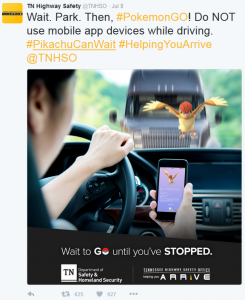 When the first social media hashtag was used in 2007, users had no idea how ubiquitous hashtags would become. Today, hashtags are an essential part of our lives (and a subject we’ve been writing about for years). From marketing a business to garnering support for a cause, hashtags have become an essential part of our society. This may even be an understatement. For instance, from May 26, 2020, until June 7, 2020, alone, the #BlackLivesMatter hashtag was used over 47 million times on Twitter. 47 million. Talk about impact.
When the first social media hashtag was used in 2007, users had no idea how ubiquitous hashtags would become. Today, hashtags are an essential part of our lives (and a subject we’ve been writing about for years). From marketing a business to garnering support for a cause, hashtags have become an essential part of our society. This may even be an understatement. For instance, from May 26, 2020, until June 7, 2020, alone, the #BlackLivesMatter hashtag was used over 47 million times on Twitter. 47 million. Talk about impact.
Articles Posted in Terms of Service
Think Before You Link: The Legal Risk with Nested Hyperlinks in Online Terms
As regulations and best practices regarding online terms continues to impose increasing requirements on operators of websites, apps and online services, a basic set of online terms can now encompass as many as half a dozen documents! One just needs to glance at the footer of most any website to see the array of policies that are now needed to minimally address commercial and legal considerations. A normal schema of online terms includes: Terms of Service, an Acceptable Use Policy, a Copyright/DMCA Policy, a Privacy Policy, a Cookie Policy, and a California Privacy Notice. All of these various policies typically wrap up into the Terms of Service. From a practical standpoint, and in some instances out of legal necessity, it is best to break these policies into separate documents and utilize hyperlinks and other embedded text to create a structure that can be navigated electronically. To date, this has seemed to be a reasonable approach and is particularly favored by web and app designers who strive to create clean screens with streamlined text.
But beware—nesting hyperlinks to various policies within a master set of terms can lead to trouble.
News of Note for the Internet-Minded – 11/9/17 – Harry Potter Go?, Chatbot, Esq. and DARPA
The End of the Form Contract as a Shield against Negative Opinion
In a December post titled “Freedom to Yelp: Congress Curbs ToS Overreach,” we discussed the Consumer Review Fairness Act of 2016, then just awaiting President Obama’s signature to become law. That happened, and the law goes into effect March 14. In their recent client alert on the new federal law, colleagues Michael Heuga, Amy Pierce and Catherine Meyer delve into the details, examining what exactly the law prohibits, what is still permitted, and what possible penalties await businesses found to be in violation.
Do Not Wait until Midstream to Revisit Content Sharing Agreements
As more and more content that has traditionally only been offered over-the-air, through cable, or on satellite becomes increasingly available via the internet, television content providers must take care in scrutinizing their existing broadcasting agreements to avoid potential conflicts with their current distribution affiliates. Although the internet offers content creators the ability to distribute media directly to their audiences, television networks will face a host of issues if they are not careful in structuring their approach to this new media paradigm.
The Freedom to Yelp: Congress Curbs ToS Overreach
Worried about a company retaliating against you when you post a negative review on Yelp or TripAdvisor? Worry no longer because Congress has your back. Last week, Congress passed a law that will make it illegal for companies to retaliate against U.S. consumers who post negative reviews online.
Pokémon Go and the Evolving Arena of Clickwrap Enforcement against Children
According to the official Pokémon website, “kids all over the world have been discovering the enchanting world of Pokémon [for over 15 years].” Not surprisingly, many of us who used to be kids in the 15+ years are playing Pokémon Go, but who would have expected nearly 4 of every 5 Pokémon Go players (almost 80%) to be adults. Put into perspective—at Pokémon Go’s peak of 25 million daily active users, close to 20 million adults may have been playing the location-based augmented reality mobile game every day! Still, that also means at least one out of every five players are children, which in turn represents millions of daily active users against whom one or more provisions of Pokémon Go’s Terms of Service (TOS) might be unenforceable.
Pokémon Go Ushers in a New, Augmented World of Legal Liability Concerns
 We predicted last year that 2016 would be the year of Pokémon. This prophecy came true last week within just two days of the Pokémon Go launch. The location-based augmented reality mobile game/app quickly surpassed Tinder in daily users and neared Twitter’s totals (and as of yesterday, surpassed them), with its users spending twice as much time engaged with Pokémon Go relative to apps like Snapchat. This explosion has helped shares of Nintendo, partial owner of both the Pokémon Company and Niantic (which developed the game), grow over 50% in three trading days since the app’s launch. In the aftermath of the Pokémon takeover, it’s a good time to revisit some of the potential legal implications.
We predicted last year that 2016 would be the year of Pokémon. This prophecy came true last week within just two days of the Pokémon Go launch. The location-based augmented reality mobile game/app quickly surpassed Tinder in daily users and neared Twitter’s totals (and as of yesterday, surpassed them), with its users spending twice as much time engaged with Pokémon Go relative to apps like Snapchat. This explosion has helped shares of Nintendo, partial owner of both the Pokémon Company and Niantic (which developed the game), grow over 50% in three trading days since the app’s launch. In the aftermath of the Pokémon takeover, it’s a good time to revisit some of the potential legal implications.
Six Ways Site Design Can Potentially Render TOS Agreements Unenforceable
Our recent posts on successful legal challenges to the arbitration clauses in browsewrap and clickwrap agreements have a theme in common—even the most thorough and well-worded agreement can be rendered unenforceable by website design. With this in mind, we have put together a list of otherwise innocuous web design components that can be the bane of both browsewrap and clickwrap alike. Note, failure to pay attention to any one of these will not necessarily render your agreement weightless—many of these are culprits only when grouped together—but they are also each eminently addressable, so why not avoid potential pitfalls in the first place?
Clickwrap Kryptonite: Don’t Let Site Design Undermine Your TOS
 We previously covered the developing legal issues with browsewrap agreements and the importance of reviewing and updating any such agreement to ensure users are bound to the terms. In a browsewrap agreement, the user’s assent to the agreement’s terms is inferred from the user’s use of the website. Often, the terms of a browsewrap agreement are accessible from a hyperlink placed on one or more webpages of the company’s website. As we mentioned in our initial post, browsewrap agreements have a close, usually more dependable relative—the “clickwrap” agreement. A clickwrap agreement requires the user to click a button to affirm assent to the agreement’s terms. As a result of this direct, affirmative action, many lawyers view clickwrap as a safer alternative than its browsewrap cousin.
We previously covered the developing legal issues with browsewrap agreements and the importance of reviewing and updating any such agreement to ensure users are bound to the terms. In a browsewrap agreement, the user’s assent to the agreement’s terms is inferred from the user’s use of the website. Often, the terms of a browsewrap agreement are accessible from a hyperlink placed on one or more webpages of the company’s website. As we mentioned in our initial post, browsewrap agreements have a close, usually more dependable relative—the “clickwrap” agreement. A clickwrap agreement requires the user to click a button to affirm assent to the agreement’s terms. As a result of this direct, affirmative action, many lawyers view clickwrap as a safer alternative than its browsewrap cousin.
 Internet & Social Media Law Blog
Internet & Social Media Law Blog



